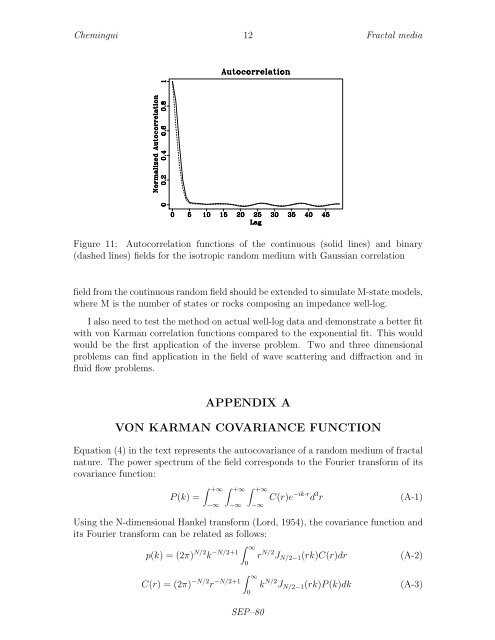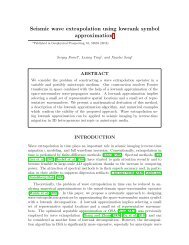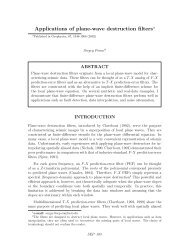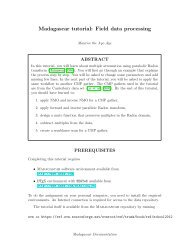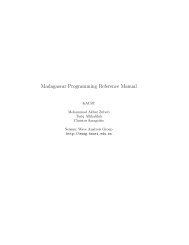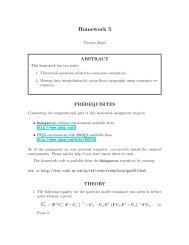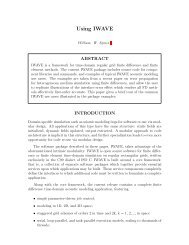Chemingui 12 Fractal media Figure 11: Autocorrelation functions of the continuous (solid lines) and binary (dashed lines) fields for the isotropic random medium with Gaussian correlation field from the continuous random field should be extended to simulate M-state models, where M is the number of states or rocks composing an impedance well-log. I also need to test the method on actual well-log data and demonstrate a better fit with von Karman correlation functions compared to the exponential fit. This would would be the first application of the inverse problem. Two and three dimensional problems can find application in the field of wave scattering and diffraction and in fluid flow problems. APPENDIX A VON KARMAN COVARIANCE FUNCTION Equation (4) in the text represents the autocovariance of a random medium of <strong>fractal</strong> nature. The power spectrum of the field corresponds to the Fourier transform of its covariance function: P (k) = ∫ +∞ ∫ +∞ ∫ +∞ −∞ −∞ −∞ C(r)e −ik·r d 3 r (A-1) Using the N-dimensional Hankel transform (Lord, 1954), the covariance function and its Fourier transform can be related as follows: ∫ ∞ p(k) = (2π) N/2 k −N/2+1 r N/2 J N/2−1 (rk)C(r)dr 0 ∫ ∞ C(r) = (2π) −N/2 r −N/2+1 k N/2 J N/2−1 (rk)P (k)dk 0 SEP–80 (A-2) (A-3)
Chemingui 13 Fractal media where J N/2−1 is the Bessel function of order N/2 − 1. The covariance C(r) in (3) is specified in terms of the function: G ν (r) = r ν K ν (r) 0 ≤ r < ∞ ν ∈ [0, 1] (A-4) whose Hankel transform pair has been derived by Lord (1954): P (k) = where Γ is the gamma function defined as: Γ(ν + N/2) 2 1−N−ν π N /2 (1 + k2 ) −ν−N/2 (A-5) Γ(z) = ∫ ∞ 0 t z−1 e −t dt (A-6) Finally if we normalize G ν (r) by G ν (0) as in Goff and Jordan (1988), we obtain, for the three-dimensional case, the power spectrum of the field whose covariance is defined by (4): P (k) = 4πνH 2 (1 + k 2 ) (−ν−3/2) (A-7) REFERENCES Bracewell, R., 1978, The Fourier transform and its application: McGraw-Hill, New York. Chernov, L. A., 1960, Wave propagation in a random medium: McGraw-Hill, New York. Feller, W., 1971, An introduction to probability theory and its applications: Vol. 2: John Wiley, New York. Frankel, A., and R. W. Clayton, 1986, Finite difference simulations of seismic scattering: Implications for the propagation of short-period seismic waves in the crust and models of crustal heterogeneity: Journal of Geophysical Research, 91, 6465–6489. Godfrey, R., F. Muir, and F. Rocca, 1980, <strong>Modeling</strong> seismic impedance with Markov chains: Geophysics, 45, 1351–1372. Goff, J. A., and T. H. Jordan, 1988, Stochastic modeling of seafloor morphology: Inversion of sea beam data for second-order statistics: Journal of Geophysical Research, 93, 13,589–13,608. Holliger, K., and A. R. Levander, 1992, A stochastic view of lower crustal fabric based on evidence from the Ivrea zone: Geophysical Research Letters, 19, 1153–1156. Holliger, K., A. R. Levander, and J. A. Goff, 1993, Stochastic modeling of the reflective lower crust: petrophysical and geological evidence from the Ivrea zone (Northern Italy): Journal of Geophysical Research, 98, 11967–11980. Lord, R. D., 1954, The use of the Hankel transform in statistics: I. General theory and examples: Biometrika, 41, 44–55. Mandelbrot, B. B., 1983, The <strong>fractal</strong> geometry of nature: W. H. Freeman, New York. ——–, 1985, Self-affine <strong>fractal</strong>s and and <strong>fractal</strong> dimension: Phys. Scrip., 32, 257–260. Matern, B., 1970, Spatial variation: Medd. Skogsforskn Inst., 49(5), 1–144. SEP–80


